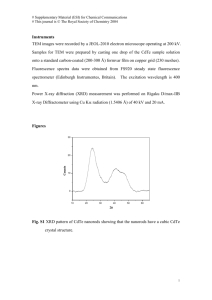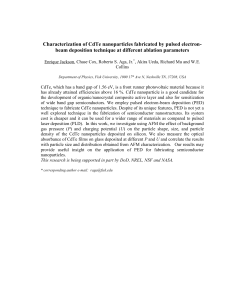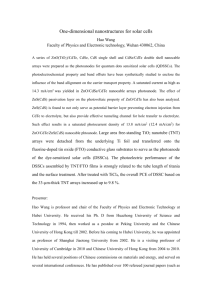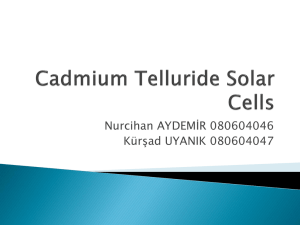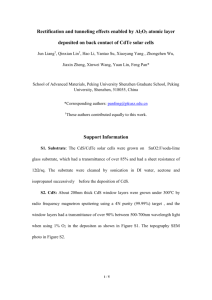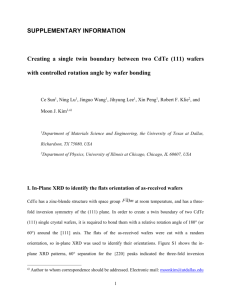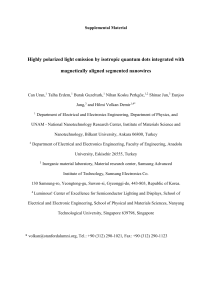Cadmium is released into the environment from phosphate fertilizers
advertisement
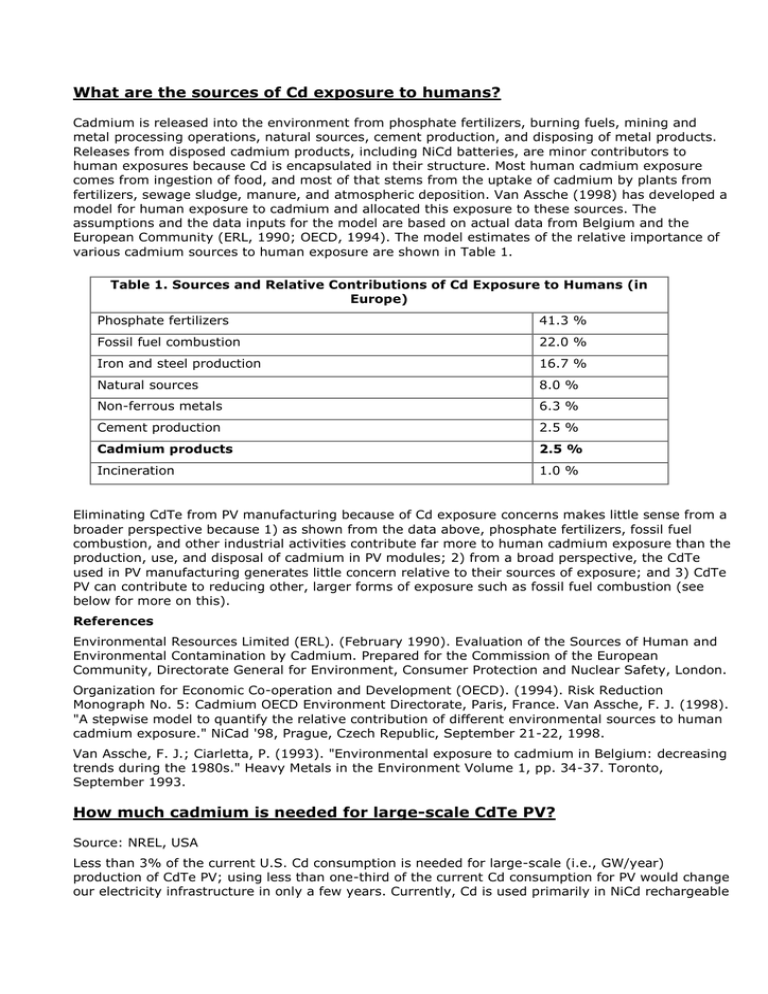
What are the sources of Cd exposure to humans? Cadmium is released into the environment from phosphate fertilizers, burning fuels, mining and metal processing operations, natural sources, cement production, and disposing of metal products. Releases from disposed cadmium products, including NiCd batteries, are minor contributors to human exposures because Cd is encapsulated in their structure. Most human cadmium exposure comes from ingestion of food, and most of that stems from the uptake of cadmium by plants from fertilizers, sewage sludge, manure, and atmospheric deposition. Van Assche (1998) has developed a model for human exposure to cadmium and allocated this exposure to these sources. The assumptions and the data inputs for the model are based on actual data from Belgium and the European Community (ERL, 1990; OECD, 1994). The model estimates of the relative importance of various cadmium sources to human exposure are shown in Table 1. Table 1. Sources and Relative Contributions of Cd Exposure to Humans (in Europe) Phosphate fertilizers 41.3 % Fossil fuel combustion 22.0 % Iron and steel production 16.7 % Natural sources 8.0 % Non-ferrous metals 6.3 % Cement production 2.5 % Cadmium products 2.5 % Incineration 1.0 % Eliminating CdTe from PV manufacturing because of Cd exposure concerns makes little sense from a broader perspective because 1) as shown from the data above, phosphate fertilizers, fossil fuel combustion, and other industrial activities contribute far more to human cadmium exposure than the production, use, and disposal of cadmium in PV modules; 2) from a broad perspective, the CdTe used in PV manufacturing generates little concern relative to their sources of exposure; and 3) CdTe PV can contribute to reducing other, larger forms of exposure such as fossil fuel combustion (see below for more on this). References Environmental Resources Limited (ERL). (February 1990). Evaluation of the Sources of Human and Environmental Contamination by Cadmium. Prepared for the Commission of the European Community, Directorate General for Environment, Consumer Protection and Nuclear Safety, London. Organization for Economic Co-operation and Development (OECD). (1994). Risk Reduction Monograph No. 5: Cadmium OECD Environment Directorate, Paris, France. Van Assche, F. J. (1998). "A stepwise model to quantify the relative contribution of different environmental sources to human cadmium exposure." NiCad '98, Prague, Czech Republic, September 21-22, 1998. Van Assche, F. J.; Ciarletta, P. (1993). "Environmental exposure to cadmium in Belgium: decreasing trends during the 1980s." Heavy Metals in the Environment Volume 1, pp. 34-37. Toronto, September 1993. How much cadmium is needed for large-scale CdTe PV? Source: NREL, USA Less than 3% of the current U.S. Cd consumption is needed for large-scale (i.e., GW/year) production of CdTe PV; using less than one-third of the current Cd consumption for PV would change our electricity infrastructure in only a few years. Currently, Cd is used primarily in NiCd rechargeable batteries (~65%), paint pigments (~17%), plastic stabilizers (~10%), metal plating (~5%), and metal solders (~2%) (Fig. 1). In 1997, the total Cd use in the United States was 2,600 tons; globally the total use is 19,000 to 20,000 tons. But to change the world's energy infrastructure with CdTe PV, much less Cd than is already used for other purposes would be needed, and it might not impact the overall smelting of Cd at all! In fact, it would provide a beneficial use of Cd that could otherwise be cemented or end up in a waste dump. Why? Using only 3% of the U.S. consumption of cadmium in the manufacture of CdTe solar cells (i.e., 78 tons) would generate more than 1 GW of new PV per year. Note that the total current PV capacity in the United States is only 0.3 GW and is projected to grow (under optimistic assumptions) to about 3.2 GW/yr by the year 2020. Even if we envision an order of magnitude higher PV production, this would require only about one-third of the current U.S. Cd consumption. The result would be new solar energy of 10 GW/year, which would quickly accumulate and significantly change the mix of electricity sources in the United States and abroad, preventing carbon dioxide and other emissions. References Anderson, B. A. (2000). Materials availability for large-scale thin film photovoltaics. Progress in Photovoltaics, 8, pp. 61-76. Cadmium Market Update Analysis and Outlook. (1995). Roskill Information Services Ltd., London, UK. Can the CdTe in PV modules harm our health or the environment? Source: NREL, USA Toxic compounds cannot cause adverse health effects unless they enter the body in harmful doses. The only means by which people might be exposed to compounds from a finished PV module are by accidentally ingesting flakes or dust particles or inhaling dust and fumes. The thin CdTe/CdS layers are stable and solid and are encapsulated between thick layers of glass. Unless the module is ground to a fine dust, dust particles cannot be generated. The vapor pressure of CdTe at ambient conditions is zero. Therefore, it is impossible for vapors or dust to be generated when using PV modules. See Question 11 for a discussion of fires as a potential source of exposure. The only issue of some concern is the disposal of the well-encapsulated, relatively immobile CdTe at the end of the module's useful life. Today's CdTe PV end-of-life or broken modules pass Federal (TCLP-RCRA) leaching criteria for non-hazardous waste. Therefore, according to current laws, such modules could be disposed of in landfills. However, recycling PV modules offers an important advantage, and the industry is considering this as it moves toward large and cost-effective production. The recycling issue is not unique to CdTe. The disposal of current x-Si modules, most of which incorporate Pb-based solder, presents similar concerns. Recycling the modules at the end of their useful life completely resolves any environmental concerns. References Bohland, J.; Dapkus, T.; Kamm, K.; Smigielski, K. (1998). "Photovoltaics as hazardous materials: the recycling solution." Proceedings of the 2nd IEEE World Photovoltaic Specialists Conference, pp. 716-719. Fthenakis V. (2002). "Could CdTe PV modules pollute the environment?" Aug. 2002, Brookhaven National Laboratory, Upton, NY 11973. Fthenakis, V.; Eberspacher, C.; Moskowitz, P. (1996). "Recycling strategies to enhance the commercial viability of photovoltaics." Progress in Photovoltaics, 4, pp. 447-456. Fthenakis, V.; Gonsiorawski, R. (1999). Lead-free solder technology from ASE Americas, Workshop Report BNL67536, Oct. 19, 1999, Brookhaven National Laboratory, Upton, NY 11973. Steinberger, H. (1997). HSE for CdTe and CIS thin film module operation, IEA expert workshop. "Environmental aspects of PV power systems." May 23, 1997, Report No. 97072, Niewlaar E. and Alsema E. (ed.), Utrecht University, The Netherlands. How much Cd is used in CdTe modules per kW of power produced? Source: NREL, USA Cd per kW: 70 g/kW Cd per MW: 70 kg/MW Cd per GW: 70 metric tons (MT)/GW A CdTe module of 10% sunlight-to-electricity conversion efficiency produces about 100 W of output under standard sunlight conditions; therefore, the average is 7 g/100 W = 70 g per kW of electric power produced. How much Cd is used in a CdTe module per kWh of electricity produced (in an average U.S. solar location)? Source: NREL, USA Cd in a module per kWh: 0.001 g/kWh Cd per MWh: 1 g/MWh Cd per GWh: 1 kg/GWh In an average solar location in the United States, such as Kansas, a one-square-meter, 10%efficient CdTe module containing 7 g of Cd produces about 5,400 kWh over its expected service life of 30 years. That amounts to about 770 kWh per gram of Cd, or 0.001 g/kWh. (Note: this amount is contained in the module and is NOT an emission. The Cd can be completely recycled. Does the compound CdTe pose the same health risk as elemental Cd? Source: NREL, USA Although long-term exposure to elemental cadmium, a carcinogen, can have detrimental effect on kidneys and bones, limited data exist on CdTe toxicology. However, CdTe is more stable and less soluble than elemental Cd and therefore is likely to be much less toxic. Although the Occupational Safety & Health Administration (OSHA) does not make this distinction, as a general rule, all facilities working with such compounds are encouraged to control the indoor concentrations of CdTe dust or fumes to below the Permissible Exposure Level-Time Weighted Average (PEL-TWA) Cd concentration of 0.005 mg/m3. The U.S. CdTe PV industry is vigilant in preventing health risks and has established proactive programs in industrial hygiene and environmental control. Workers' exposure to cadmium compounds in PV manufacturing facilities is controlled by rigorous industrial hygiene practices and is continuously monitored by medical tests, thus minimizing health risks. References Fthenakis, V.; Morris, S.; Moskowitz, P.; Morgan, D. (1999). "Toxicity of cadmium telluride, copper indium diselenide, and copper gallium diselenide." Progress in Photovoltaics, 7, pp. 489-497. Bohland, J.; Smigielski, K. (September 2000). First Solar's CdTe module manufacturing experience: environmental, health, and safety results. Proceedings of the 28 th IEEE Photovoltaic Specialists Conference, Anchorage, AK. How much cadmium (Cd) is encapsulated in cadmium telluride (CdTe) modules? Source: NREL, USA CdTe modules encapsulate about 7 g/m2 (the range is from 3 to 10 g/m2) of Cd, mainly in the form of CdTe. The amount of Cd compounds in PV modules is proportional to the area of the module and the thickness of the CdTe and CdS layers. A one-square-meter area of CdTe one micron thick contains about 2.9 g of Cd. The same area of CdS contains about 3.7 g of Cd. Most CdTe layers are about 1-3 microns thick, and most CdS layers are about 0.2 microns thick. This means that the CdTe layer contains from 3 to 9 g/m2 Cd, and CdS contains less than 1 g/m2. It is expected that layer thickness will be reduced as research and development efforts continue, further reducing the amount of Cd compounds in the cells. References Anderson, B. A. (2000). "Materials availability for large-scale thin film photovoltaics." Progress in Photovoltaics, 8, pp. 61-76. Zweibel, K. (1997). "Reducing ES&H impacts from thin film PV." Environmental Aspects of PV Power Systems, Utrecht University, The Netherlands. Zweibel, K. (1999). "Issues in thin film PV manufacturing cost reduction." Solar Energy Materials and Solar Cells, 59, pp. 1-18. Do CdTe modules present health risks during a fire? Source: NREL, USA The flame temperature in typical U.S. residential fires is not high enough to vaporize CdTe. Flame temperatures in roof fires range from 800º-900º C, aand flame temperatures in basement rooms range from 900º-1000º C.1 The melting point of CdTe is 1041ºC, and evaporation starts at 1050ºC. Sublimation occurs at lower temperatures, but the vapor pressure of CdTe at 800ºC is only 2.5 torr (0.003 atm). The melting point of CdS is 1750ºC, and its vapor pressure due to sublimation at 800ºC is only 0.1 torr. Preliminary studies at Brookhaven National Laboratory2 and at the GSF Institute of Chemical Ecology in Germany3 showed that CdTe releases are unlikely to occur during residential fires or during accidental breakage.4 The thin layers of CdTe and CdS are sandwiched between the glass plates, and at typical flame temperatures (800º-1000ºC), these compounds would be encapsulated inside the molten glass, so any Cd vapor emissions are unlikely. References 1. Drysdale, D. (1985). An Introduction to Fire Dynamics, pp. 329-330, Wiley, NY. 2. Moskowitz, P; Fthenakis, V. (1990). Toxic materials released from photovoltaic modules during fires; health risks, Solar Cells, 29, pp. 63-71. 3. Thumm, W.; Finke, A.; Nuemeier, B.; Beck, B.; Kettrup, A.; Steinberger, H.; Moskowitz, P. (1994). "Environmental and health aspects of CIS-module production, use, and disposal." Presented at the First World Conference on Photovoltaic Energy Conversion, Waikoloa, Hawaii, 5-9 December 1994. 4. Steinberger, H. (1997). HSE for CdTe and CIS thin film module operation, IEA expert workshop "Environmental aspects of PV power systems," May 23, 1997, Report No. 97072, Niewlaar E. and Alsema E. (ed.), Utrecht University, The Netherlands. 5. Patterson, M.; Turner, A.; Sadeghi, M.; Marshall, R. (1994). "HSE aspects of the production and use of CdTe thin film modules." Presented at the 12th European PV Solar Energy Conference, Amsterdam. On a per-kWh basis, how much Cd is contained in CdTe modules, compared with the amount of Cd in NiCd batteries? Source: NREL, USA Over the life of a CdTe module (without recycling) versus the life of a NiCd battery, the PV module uses Cd about 2,500 times more efficiently in producing electricity. (If either or both are recycled, this would improve the efficiency of using the Cd/kWh of output.) If a size-AA or size-C NiCd battery is recharged about 1,000 times, it produces about 310 Wh/g over its life—2,500 times less than a CdTe PV module. Thus, the value of using Cd in PV is much greater than its value elsewhere in the marketplace. References Leclanche. "The rechargeable batteries".. Accessed January 6, 2003. Morrow, H. (1998). "The importance on recycling to life cycle analysis of nickel cadmium batteries." Proceedings of the 8th International Nickel Cadmium Battery Conference, Prague, Czech Republic, September 21-22, 1998. Steatite Group, The. "A comprehensive range of industry-proven NiCd batteries." Accessed January 6, 2003. Will CdTe PV prevent Cd emissions in the environment? Source: NREL, USA Yes! When PV replaces burning coal for electricity generation, it will prevent a minimum of 2 g of Cd in gaseous emissions and about 140 g of Cd in ash form for each GWh of electricity produced. Coal burning routinely generates Cd because coal contains Cd. A typical U.S. coal-power plant will generate waste in the form of fine dust or cake (containing about 140 g of Cd) for every GWh of electricity produced. In addition, a minimum of 2 g of Cd will be emitted from the stack (for plants with perfectly maintained electrostatic precipitators or baghouses operating at 98.6% efficiency, and median concentration of Cd in U.S. coal of 0.5 ppm). Power plants with less efficient pollution controls will produce more Cd in gaseous form. Furthermore, a typical U.S. coal-power plant emits about 1,000 tons of CO2, 8 tons of SO2, 3 tons of NOx, and 0.4 tons particulates per GWh of electricity produced. All of these emissions will be reduced when PV offsets coal-burning for some fraction of electricity generation. References Electric Power Research Institute (EPRI). (2002). PISCES database for U.S. power plants and U.S. coal, copyright EPRI 2002. Advantages of CdTe thin-film solar panel over other types of solar module Where does Cd come from? Source: NREL, USA Cadmium is a by-product of zinc, lead, and copper mining. Its major feedstock, sphalerite (ZnS), contains only 0.25% cadmium. Because Zn is produced in large quantities (8 million metric tons in 1999), substantial amounts of cadmium are produced as a by-product (no matter how much cadmium is used in the PV industry). This cadmium by-product can be put to beneficial use in PV modules or other products, or it can be discharged into the environment. When the market does not absorb the Cd generated by metal smelters/refiners, it is cemented and buried, stored for future use, or disposed of in landfills as hazardous waste. Reference Morrow, H. (17 January 2003). Personal communication. The International Cadmium Association. Plachy, J. (2001). U.S. Geological Survey Minerals Yearbook, Chapter 17: Cadmium. United States Geological Survey (USGS). Table 6: U.S. statistics for zinc. (Excel 27 KB). Accessed January 6, 2003. How much Cd is contained in nickel cadmium (NiCd) batteries, and how does this compare with the amount of Cd contained in PV modules? Source: NREL, USA CdTe modules occupying 1 m2 (10.7 ft2) contain less Cd than one size-C NiCd flashlight battery. Size AA: 3.3 g in the form of metal Cd and Cd (OH) 2 Size C: 10.5 g Size D: 21 g References Horn, G. (April 1988). "Recycling of NiCd batteries: some practical aspects." Nickel-Cadmium Battery Update Seminar, pp. 56-58, Paris, published by the Cadmium Association, London, UK. Steatite Group, The. "A comprehensive range of industry-proven NiCd batteries." Accessed January 6, 2003.
